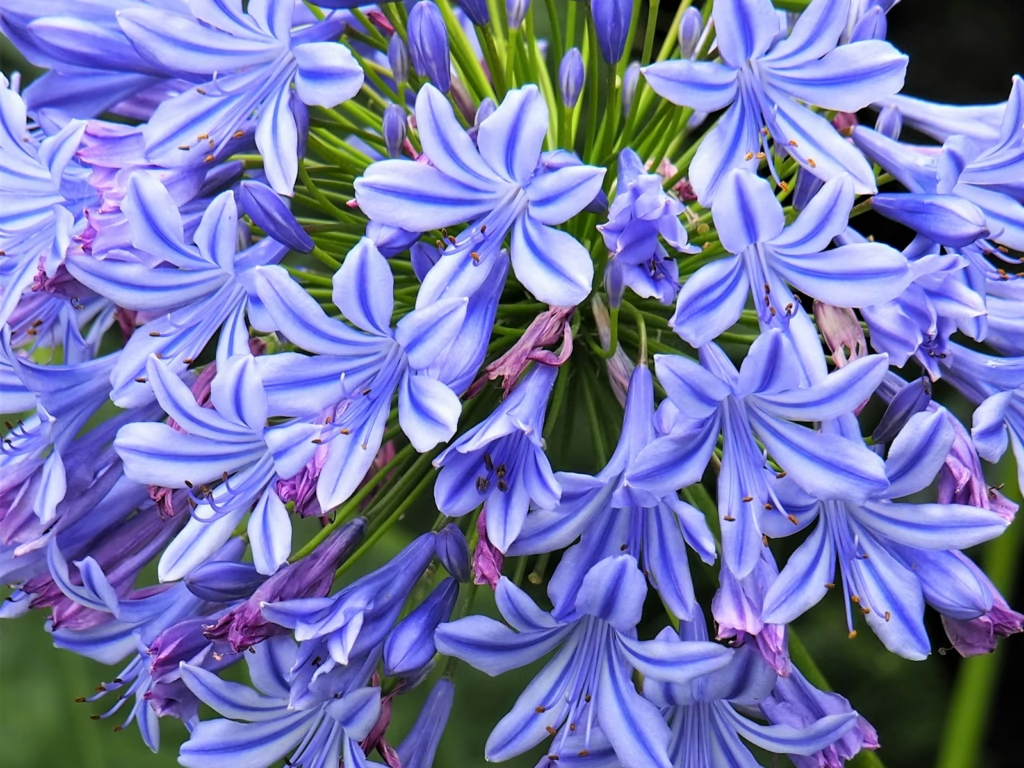Agapanthus, commonly known as the African lily, is a striking perennial celebrated for its vibrant blue or white flowers and lush, strappy foliage. Native to South Africa, these sun-loving plants add a touch of elegance to gardens and containers alike. With proper care, agapanthus can thrive and bloom beautifully year after year.

Types of Agapanthus
Agapanthus varieties are broadly categorized into two types:
- Deciduous: These varieties die back in winter and are generally more cold-hardy, tolerating temperatures down to -10°C (14°F). They are suitable for growing in borders and can be mulched for added winter protection.
- Evergreen: Retaining their foliage year-round, evergreen types are less frost-hardy, tolerating temperatures down to -5°C (23°F). They are best grown in containers that can be moved indoors or protected during colder months.
Planting Agapanthus
- Location: Choose a sunny spot with well-draining soil. Agapanthus thrives in full sun but can tolerate partial shade.
- Soil preparation: Improve heavy soils by incorporating organic matter to enhance drainage. For container planting, use a mix of two parts peat-free, multipurpose compost to one part fine grit or perlite.
- Planting Time: Plant agapanthus in spring, from late March to April, to establish before the growing season.
Care and Maintenance
- Watering: While drought-tolerant once established, agapanthus benefits from regular watering during the growing season, especially in dry periods.
- Feeding: Apply a high-potash fertilizer every two weeks from March to October to promote flowering. Avoid high-nitrogen fertilizers, which encourage foliage growth at the expense of blooms.
- Pruning: Remove spent flower heads to encourage further blooming and prevent self-seeding. Cut back deciduous varieties in late autumn after the foliage has died down.
Propagating Agapanthus
- Division: Every five to six years, divide congested clumps in spring. Lift the plant, separate the rhizomes, and replant them to promote vigorous growth.
- Growing from Seeds: Sow seeds in spring in a well-draining seed mix. Germination can take several weeks, and seedlings may take a few years to flower.
Growing Agapanthus in Pots
- Container Choice: Select a pot with adequate drainage holes.
- Soil Mix: Use a well-draining mix of two parts peat-free compost to one part grit or perlite.
- Care: Water regularly during the growing season and feed with a high-potash fertilizer. Repot every two to three years to prevent congestion.
Overwintering Agapanthus
- Deciduous Varieties: In colder climates, apply a mulch of chip bark or straw to protect the crowns during winter.
- Evergreen Varieties: Move potted plants to a frost-free location or wrap them in fleece to protect from temperatures below -5°C (23°F).
Common Pests and Issues
- Pests: Agapanthus is generally pest-resistant but can occasionally be affected by slugs, snails, and the agapanthus borer (Neuranethes spodopterodes). Regular inspection and prompt removal of pests can prevent significant damage.
- Diseases: Overwatering or poor drainage can lead to root rot. Ensure soil is well-draining and avoid waterlogging.
Frequently Asked Questions
- Q: When does agapanthus bloom?
- A: Agapanthus typically blooms from midsummer to early autumn, producing large, spherical flower heads.
- Q: Can agapanthus be grown indoors?
- A: While primarily outdoor plants, agapanthus can be overwintered indoors in pots, especially in colder climates. Ensure they receive adequate sunlight and are kept in a cool, bright location.
- Q: How often should I water Agapanthus?
- A: Water regularly during the growing season, allowing the soil to dry out slightly between waterings. Established plants are drought-tolerant but will perform better with consistent moisture.
By following these guidelines, you can enjoy the stunning beauty of agapanthus in your garden or containers, ensuring healthy growth and abundant blooms year after year.



